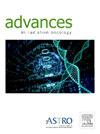Optimizing Dose Reduction to the Left Anterior Descending Artery in Patients With Locally Advanced Lung Cancer Treated With Definitive Radiation Therapy: A Feasibility Study of Coplanar Treatments Using Double-Stacked Multileaf Collimator
IF 2.7
Q3 ONCOLOGY
引用次数: 0
Abstract
Purpose
Recent studies have shown that cardiac substructures and particularly left anterior descending artery (LAD) dose strongly correlates with the incidence of late adverse cardiac events. We evaluated whether greater cardiac and, importantly, LAD dose sparing could be achieved using a newly introduced closed bore (O-ring gantry) linac with a double-stacked multileaf collimator (Varian Ethos) relative to conventional linacs.
Methods and Materials
Twenty patients with locally advanced non-small cell lung cancer previously treated with definitive chemoradiotherapy were retrospectively evaluated. Volumetric modulated arc therapy plans were retrospectively generated for the Ethos system using optimization criteria focused on reducing overall heart and LAD doses (Heart_Ethos). Plans were also reoptimized using the same optimization criteria on a conventional C-arm linac (Heart_TB). Investigational plans were compared with the original plans and with each other using standard dose-volume histogram metrics such as percentage (V) volume receiving a specific dose (x) in Gy (Vx) or mean dose (Dmean) in Gy.
Results
Statistically significant decreases existed between the Heart_Ethos and original plans for mean heart dose (11.3 vs 14.8 Gy; P < .001) and V5, V30, and V50 (63.6% vs 75.2%; P < .001, 7.1% vs 12.3%; P < .001, 2.1% vs 2.9%; P = .03, respectively) and also for LAD mean dose (4.8 Gy vs 12.0 Gy [P < .001]) and V15 (4.9% vs 21.5%; P < .001). Compared with Heart_TB, Heart_Ethos plans had significantly less mean heart dose (11.6 vs 12.2 Gy; P = .006), and less heart V5 (64.4% vs 67.2%; P = .049) and V30 (7.7% vs 8.8%; P = .03), whereas other parameters were not significant. Optimal target coverage and other organs at risk constraints were maintained for all generated plans.
Conclusions
Heart_Ethos plans showed significant reduction in cardiac and LAD doses in comparison to the original plans while maintaining target and organ at risk goals. Our findings suggest that Ethos technology has the potential for better cardiac toxicity safety because Heart_Ethos plans were still able to reduce cardiac dose compared with Heart_TB plans.
局部晚期肺癌确诊放疗患者左前降支最佳减剂量:双叠多叶准直镜共面治疗的可行性研究
最近的研究表明,心脏亚结构,特别是左前降支(LAD)剂量与晚期心脏不良事件的发生率密切相关。我们评估了与传统直线仪相比,使用新引入的带有双叠多叶准直器(Varian Ethos)的闭孔(o形环龙门)直线仪是否可以实现更大的心脏和重要的LAD剂量节约。方法与材料对20例局部晚期非小细胞肺癌患者进行回顾性分析。采用优化标准(Heart_Ethos),回顾性地为Ethos系统生成了体积调制弧线治疗方案,重点是减少心脏和LAD的总剂量。在传统c臂直线机(Heart_TB)上使用相同的优化标准对计划进行了重新优化。使用标准剂量-体积直方图指标,如接受特定剂量(x) Gy的百分比(V)体积(Vx)或Gy的平均剂量(Dmean),将研究计划与原始计划进行比较。结果Heart_Ethos与原计划的心脏平均剂量有统计学意义的降低(11.3 Gy vs 14.8 Gy;P & lt;.001)和V5、V30和V50 (63.6% vs 75.2%;P & lt;.001, 7.1% vs 12.3%;P & lt;0.001, 2.1% vs 2.9%;P = 0.03), LAD平均剂量(4.8 Gy vs 12.0 Gy) [P <;.001])和V15 (4.9% vs 21.5%;P & lt;措施)。与Heart_TB相比,Heart_Ethos计划的平均心脏剂量显著降低(11.6 Gy vs 12.2 Gy;P = 0.006),心脏V5更少(64.4% vs 67.2%;P = 0.049)和V30 (7.7% vs 8.8%;P = .03),其他参数均无统计学意义。所有生成的计划都保持了最佳目标覆盖率和其他受风险限制的机构。结论sheart_ethos计划与原计划相比,在维持靶和器官危险目标的同时,心脏和LAD剂量显著降低。我们的研究结果表明,Ethos技术具有更好的心脏毒性安全性的潜力,因为与Heart_TB计划相比,Heart_Ethos计划仍然能够减少心脏剂量。
本文章由计算机程序翻译,如有差异,请以英文原文为准。
求助全文
约1分钟内获得全文
求助全文
来源期刊

Advances in Radiation Oncology
Medicine-Radiology, Nuclear Medicine and Imaging
CiteScore
4.60
自引率
4.30%
发文量
208
审稿时长
98 days
期刊介绍:
The purpose of Advances is to provide information for clinicians who use radiation therapy by publishing: Clinical trial reports and reanalyses. Basic science original reports. Manuscripts examining health services research, comparative and cost effectiveness research, and systematic reviews. Case reports documenting unusual problems and solutions. High quality multi and single institutional series, as well as other novel retrospective hypothesis generating series. Timely critical reviews on important topics in radiation oncology, such as side effects. Articles reporting the natural history of disease and patterns of failure, particularly as they relate to treatment volume delineation. Articles on safety and quality in radiation therapy. Essays on clinical experience. Articles on practice transformation in radiation oncology, in particular: Aspects of health policy that may impact the future practice of radiation oncology. How information technology, such as data analytics and systems innovations, will change radiation oncology practice. Articles on imaging as they relate to radiation therapy treatment.
 求助内容:
求助内容: 应助结果提醒方式:
应助结果提醒方式:


